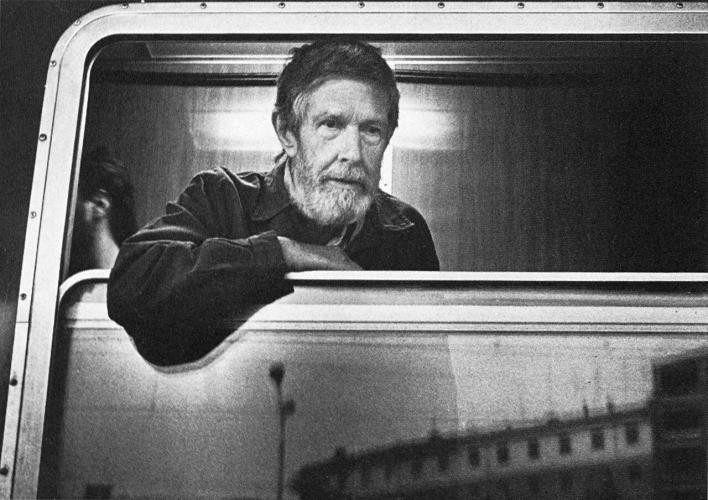An ear alone is not a being
22 Jul - 28 Oct 2012

John Cage
Music Festival of Bologna il treno di Cage, 1979
Foto: Nino Monastra
© Grafis edizioni d’ arte / John Cage Trust 2012
Music Festival of Bologna il treno di Cage, 1979
Foto: Nino Monastra
© Grafis edizioni d’ arte / John Cage Trust 2012
AN EAR ALONE IS NOT A BEING
John Cage zum 100. Geburtstag
22 July - 28 October 2012
In one of his many lectures, held in 1958 in Darmstadt and published in 1961 in the book Silence, John Cage (1912–92) said: "An ear alone is not a being. ... It becomes evident that music itself is an ideal situation, not a real one". These statements reveal key tenets of Cage's thinking and way of working, which had an enormous impact on the development of music and visual art in the second half of the 20th century.
Like Marcel Duchamp, with whom he maintained a close friendship, John Cage significantly expanded the concept of the work of art. Pushing the genre boundaries of music, sculpture, drawing and performance, he sought to close the gap between the artist, the work and the audience. Indeterminability and unpredictability were key elements of his chosen method, employed for example in his most famous composition, 4'33" (1952), where the pianist is instructed to sit quietly at an open grand piano for 4 minutes and 33 seconds, without playing a single note. The ambient sounds created in the concert hall during this time constitute the piece. It is composed silence, a creative proposition based on the premise that every sound can be music. The use of 'found' sounds became an important element within Cage's practice, reflecting his aim of remaining outside the work. "The attitude I take is that everyday life is more interesting than forms of celebration, when we become aware of it. That when is when our intentions go down to zero." (Cage, 1989)
John Cage developed complex methods to explore the possibilities of non-intention; in 1951, for example, he began applying chance operations based on the I Ching (the Chinese 'Book of Changes') to his musical compositions, texts and graphic works. This involved using the I Ching to determine the position of a pencil or an incised copper plate on a sheet of paper. The artist's imagination was replaced by the principle of chance. By allowing the work to manifest itself, Cage applied Duchamp's notion of the 'readymade' in a modified form to musical composition and established it as a process in the realm of visual art. With this approach, which redefined the aesthetic experience, Cage became an important teacher for members of the Fluxus movement and also staged the very first 'happening'.
The Hamburger Kunsthalle owns a fine selection of works by John Cage, including prints, objects and audio pieces, which are being presented together for the first time in the Saal der Meisterzeichnung (Hall of Master Drawings) to celebrate the centenary of his birth.
Curated by Luisa Pauline Fink
John Cage zum 100. Geburtstag
22 July - 28 October 2012
In one of his many lectures, held in 1958 in Darmstadt and published in 1961 in the book Silence, John Cage (1912–92) said: "An ear alone is not a being. ... It becomes evident that music itself is an ideal situation, not a real one". These statements reveal key tenets of Cage's thinking and way of working, which had an enormous impact on the development of music and visual art in the second half of the 20th century.
Like Marcel Duchamp, with whom he maintained a close friendship, John Cage significantly expanded the concept of the work of art. Pushing the genre boundaries of music, sculpture, drawing and performance, he sought to close the gap between the artist, the work and the audience. Indeterminability and unpredictability were key elements of his chosen method, employed for example in his most famous composition, 4'33" (1952), where the pianist is instructed to sit quietly at an open grand piano for 4 minutes and 33 seconds, without playing a single note. The ambient sounds created in the concert hall during this time constitute the piece. It is composed silence, a creative proposition based on the premise that every sound can be music. The use of 'found' sounds became an important element within Cage's practice, reflecting his aim of remaining outside the work. "The attitude I take is that everyday life is more interesting than forms of celebration, when we become aware of it. That when is when our intentions go down to zero." (Cage, 1989)
John Cage developed complex methods to explore the possibilities of non-intention; in 1951, for example, he began applying chance operations based on the I Ching (the Chinese 'Book of Changes') to his musical compositions, texts and graphic works. This involved using the I Ching to determine the position of a pencil or an incised copper plate on a sheet of paper. The artist's imagination was replaced by the principle of chance. By allowing the work to manifest itself, Cage applied Duchamp's notion of the 'readymade' in a modified form to musical composition and established it as a process in the realm of visual art. With this approach, which redefined the aesthetic experience, Cage became an important teacher for members of the Fluxus movement and also staged the very first 'happening'.
The Hamburger Kunsthalle owns a fine selection of works by John Cage, including prints, objects and audio pieces, which are being presented together for the first time in the Saal der Meisterzeichnung (Hall of Master Drawings) to celebrate the centenary of his birth.
Curated by Luisa Pauline Fink
